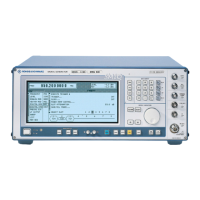Digital Standard GPS SMIQ
1125.5555.03 E-92.334
2.20 Digital Standard GPS
When equipped with the options Modulation Coder (SMIQB20), Data Generator (SMIQB11) and Digital
Standard GPS (SMIQB51), SMIQ can generate the signal of a GPS satellite. Section 2.20.1 provides an
introductory overview of the Global Positioning System (GPS). Section 2.20.2 then describes the
associated control functions. For more detailed information on generating GPS signals, refer to section
2.20.3.
2.20.1 Description of Global Positioning System (GPS)
The Global Positioning System consists of several satellites circling the earth in low orbits. The position
of a receiver on the earth can be determined by carrying out delay measurements of at least four signals
emitted by different satellites.
Being transmitted on a single carrier frequency, the signals of the individual satellites can be
distinguished by means of correlation (Gold) codes (with GPS, these codes are known as C/A codes).
Information on time and satellite orbit is contained in the navigation data emitted by each satellite. In this
case, the C/A codes are used as spreading codes (see CDMA) for the navigation data.
Each GPS satellite emits an individual navigation data sequence spread by the C/A code assigned to it
at the carrier frequency L1 = 1.57542 GHz. A GPS signal of this type (see Table 2-33 GPS system
parameters), which allows basic receiver function tests to be carried out, can be generated by SMIQ for
one satellite.
Table 2-33 GPS system parameters
Carrier frequency 1.57542 GHz
Signal level, after antenna Approx. –125 dBm to [1] and [2], depending on receive
conditions
Doppler shift -10 kHz to +10 kHz settable
Symbol rate (C/A code) 1.023 Msps
C/A codes 1 to 37 settable, 1023 chips per C/A code
Modulation BPSK
Information data rate (navigation data) 50 Hz
Frame structure of navigation data
25 frames consisting of 5 subframes where
1 subframe consists of 10 words,
1 word consists of 30 data bits,
1 data bit consists of 20460 C/A code chips.
Use of navigation data
The C/A code used is fundamental to the simulation of GPS signals. The C/A code can be set from 1 to
37 in the operating menu and specifies the satellite to be simulated.
In addition to this, navigation data play an extremely important role, since they are essential for
calculating the positions of the four satellites, which are the minimum prerequisite for localization
purposes. However, even if only one satellite is available (as simulated by SMIQ), pseudo navigation
data can be used to check the decoding of navigation information (such as GPS time, almanac and
ephemeris) in addition to the recognition of the C/A code.
Current almanac data can be downloaded via the Internet. Once converted into navigation data via PC
application software available on the Rohde & Schwarz homepage (www.rohde-schwarz.com,
Application Note 1GP46, AlmanacUploader), the data can be transferred to SMIQ as a data list. This
ensures that any navigation data records can be used for GPS signal generation in SMIQ.

